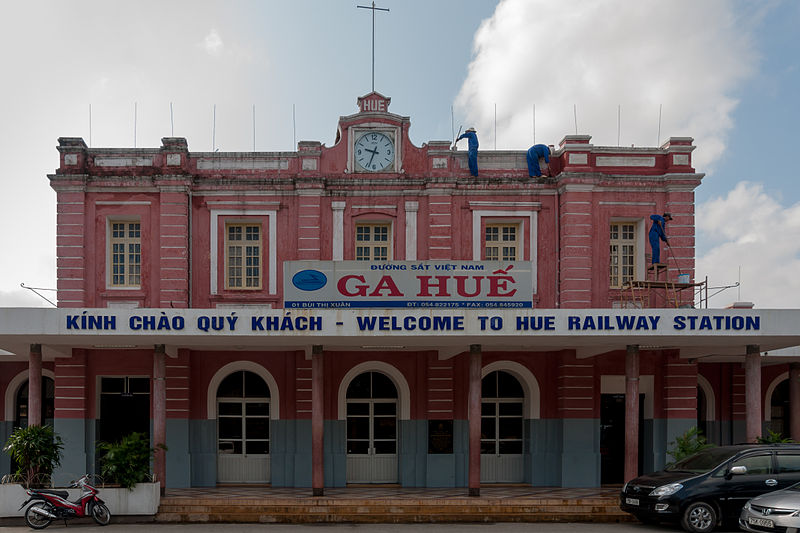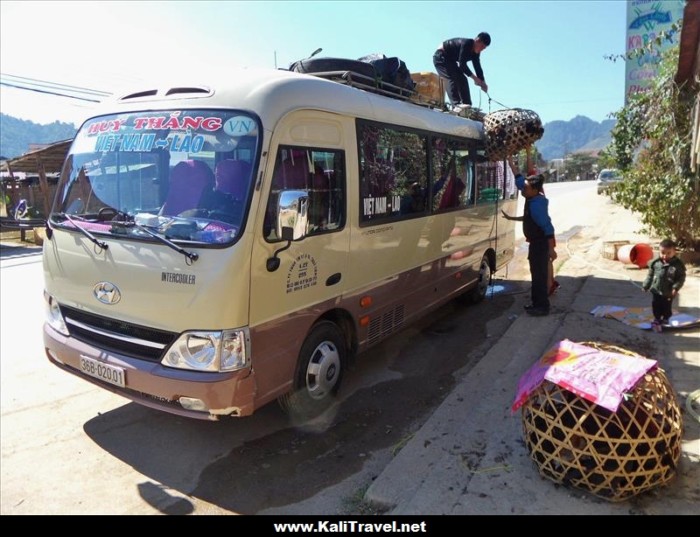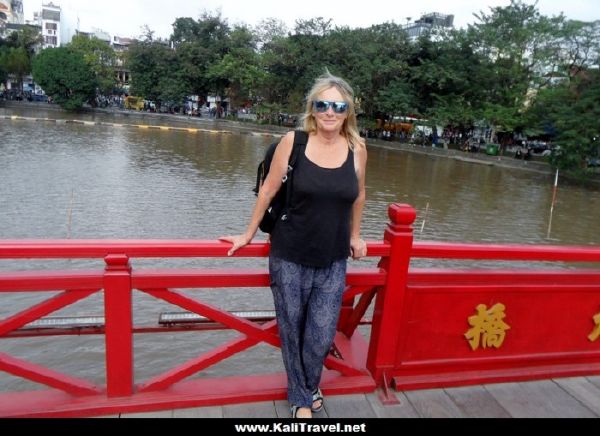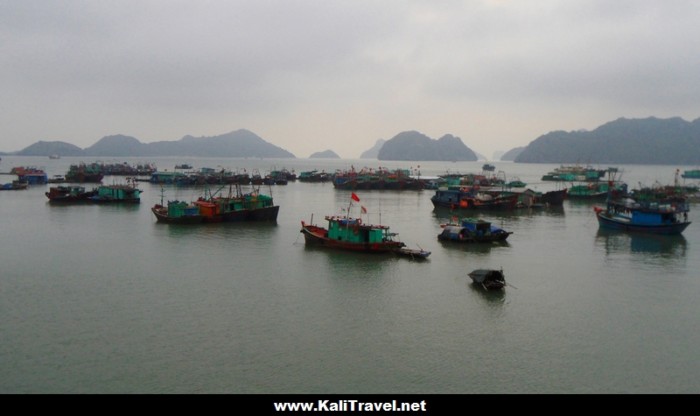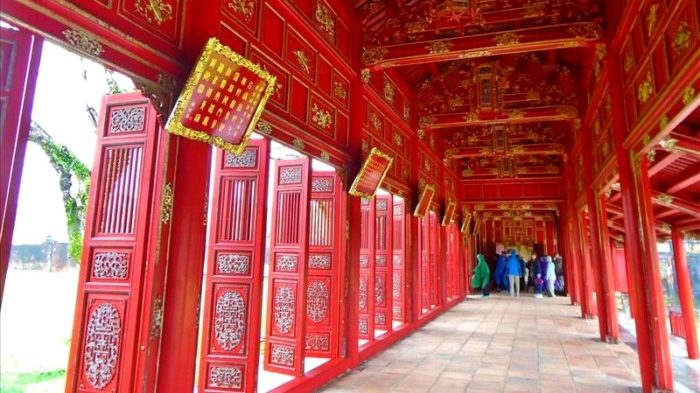Hue is the next must-see destination on our 2 week travel guide and the overnight train from Binh Ninh to Central Vietnam is a great way of getting there.
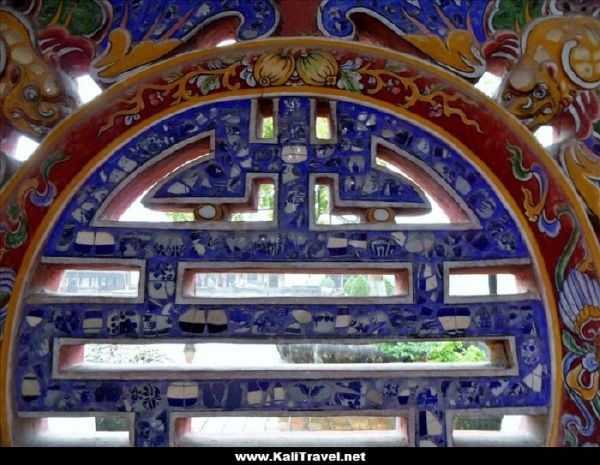
“The Perfume River flows past Huế’s Forbidden Purple Palace, its ancient tree-lined moat enfolding secret histories of times long past, as a breeze brings the fresh scent of rain on the morning air…”
Oh yes, the heavens opened and it poured down in Hue, the tail end of a tropical monsoon! But memories are made of days like this spent, rather wetly, in exceptional surroundings.
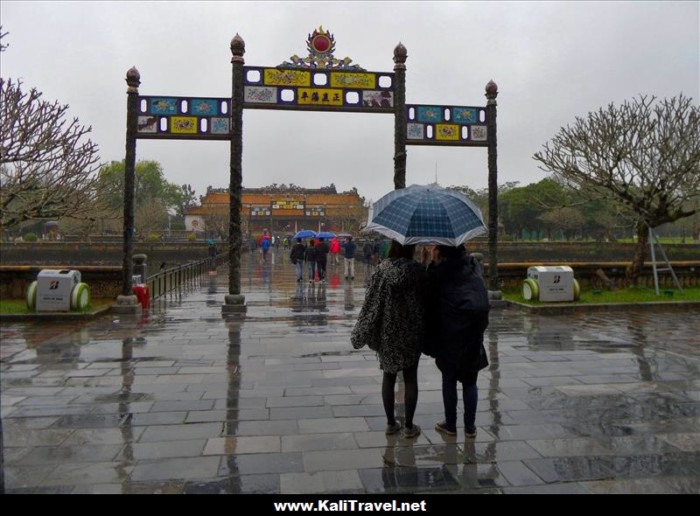
Getting the overnight train to Hue
A quick backtrack on our Vietnam adventure: Juan and I travelled up by a bus/ferry combination from Hanoi to Cat Ba Island to enjoy the scenery in Halong Bay. Catching the hydrofoil back to the mainland, we headed for Ninh Binh by coach. This is the Red River Delta, a region of green rice fields and waterways studded with giant karsts, a landscape similar to Halong Bay but on a peaceful river setting.
Unfortunately, January weather in North Vietnam can be pretty damp and the forecast is dismal so there’s no point in staying for a canoe ride through the rainy wetlands. We also missed out on trekking in Sapa or doing the Ha Giang motorbike loop for the same reason… you need sunny days to enjoy walking through the steeply terraced rice fields or riding a bike through the mountainous scenery of north Vietnam.
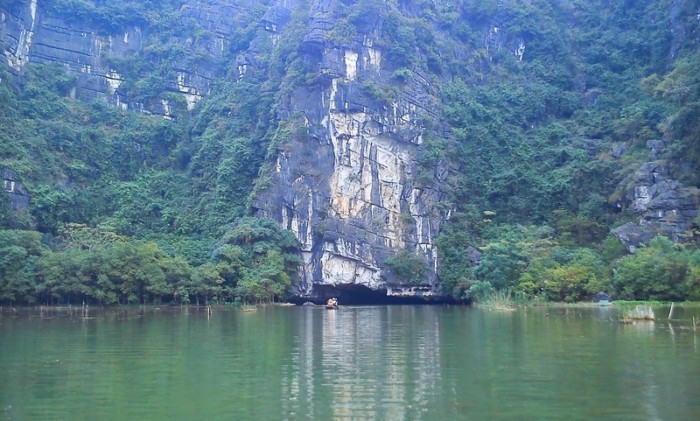
The coach drops passengers near Ninh Binh train station. A woman greets us, says we can leave our bags in the front room of her guesthouse, there’s no obligation… we’re not staying for the night but the train departs late and she does serve dinner. It’s a nondescript suburb, the grand terminal is closed, and the uninspiring cafes are full of waiting travellers.
The guesthouse is okay though, and the industrious lady who runs the place cooks for guests as well. She takes off her outdoor coat and starts the meal, authentically homemade cuisine with fresh ingredients at hand, and serves a really good chicken stir fry with aromatic lemongrass root. Meanwhile, I chat to a couple of backpackers and connect to the free internet. It’s surprising, the number of people who choose to travel solo.
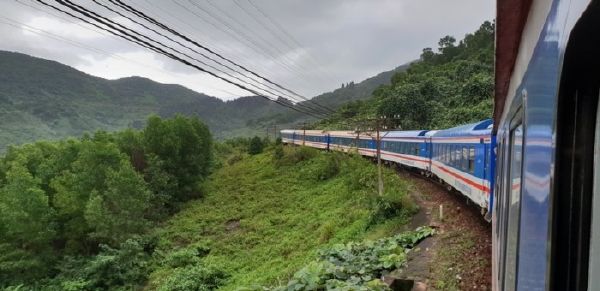
The railway station experience is odd – it’s a new building which opens shortly before the ‘Reunification Express’ is due, although the platform is still cordoned off, and there’s a modern arcade that sells overpriced snacks and drinks to take aboard.
I have tickets already booked online from a Hanoi agency but the officious booth attendant can’t fathom the computer system. He doesn’t speak any English so it’s hard to explain. Deep breath, don’t panic, keep patient and he finally manages it. The official tape is lifted just before the night express to Hue draws in.
The Reunification Line runs through the length of the country connecting north to south, from Hanoi right down to Saigon (yes, the Vietnamese generally do call Ho Chi Ming City by its former name). The night train resembles those old-fashioned types you see in epic films, the ones with wooden cabins leading off the corridor and a uniformed man with a peaked cap who ushers passengers to their berth.
A Canadian couple we met travelling in Laos are in the adjacent compartment, funny how our paths cross again almost a thousand miles on! There are two sets of bunk beds in our room which we share with a backpacker guy. I lie on my rather hard top bunk and drift asleep to the soothing rattle and rhythm of the overnight express… there’s only one stop, in the middle of the dark black night, before reaching Hue next morning.
Hue – The Imperial City
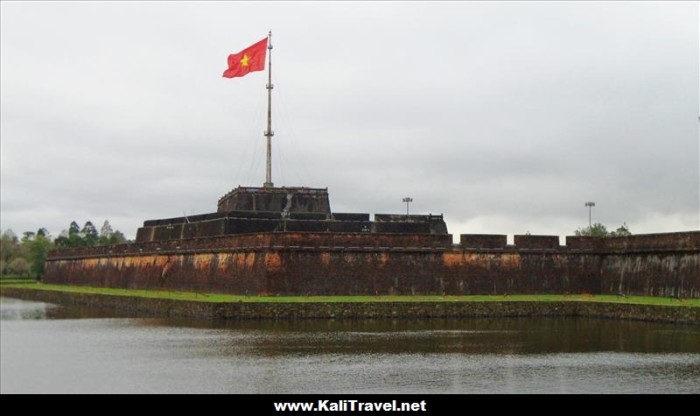
Day 1 in Hue
The town is vibrant with pedestrians and traffic though it’s not loud or overcrowded. Juan and I walk away from the pink façade of Hue’s central train station towards our hostel, telephone map app in hand, as it doesn’t seem too far. An interesting, but not deliberate detour up a hill, takes in the typical train scene of wagons passing between narrow rows of ramshackle houses. The smartass app says take a turning by the ‘coffee shop’ which is challenging, as fashionable cafés are seriously trending in Hue and there seem to be dozens around.
We’re staying in a working class district a couple of roads back from the River Perfume, on the south bank not the upper class palatial side. There’s street food, vegetable markets and fruit stalls, as well as sidewalk vendors selling filled baguettes to medics from the General Hospital and inmates in their blue pyjamas. A modern commercial zone is just around the corner, handy for essentials like a much-needed camera card to replace my full one!
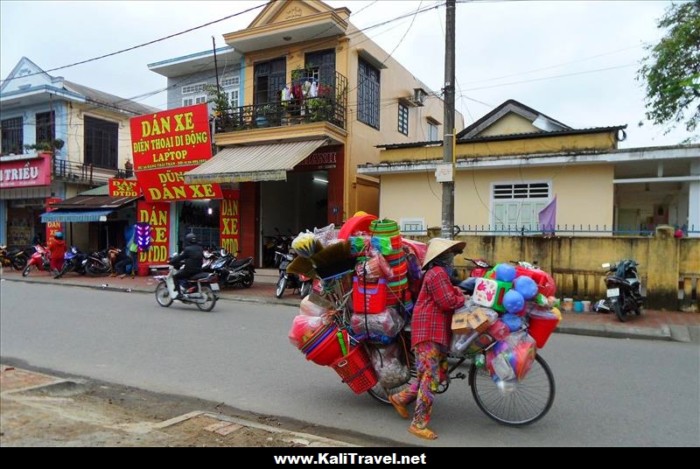
We eat at a busy little restaurant, the whole extended family works here, cooking and serving, and helping to prepare the popular takeaway rice dumplings. There are handy photo menus to choose your meals from although the teenage waitress speaks English, so it’s nice to chat to a local kid. The food is a mixture of Vietnamese and American cuisine. I didn’t see much US influence in the north of Vietnam, but it’s more obvious the further south you travel.
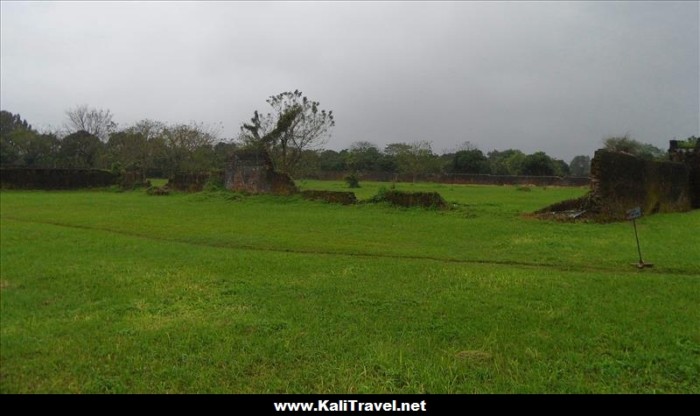
Capital of Vietnam up until 1945, Hue is located in Central Vietnam and separated from the south by the marble mountain pass. Dang is 100 kilometres away on the other side, the main operations base in the last IndoChina war; Hue’s strategic position meant it was heavily bombed by the USA at that time, although the Vietcong army wrought death and destruction too, in the notorious battle of Hue.
Some 50 years on, Hue is known as ‘City of Romance’ especially in springtime when the perfume of floating petals is brought down the Sông Hương River to scent the air.
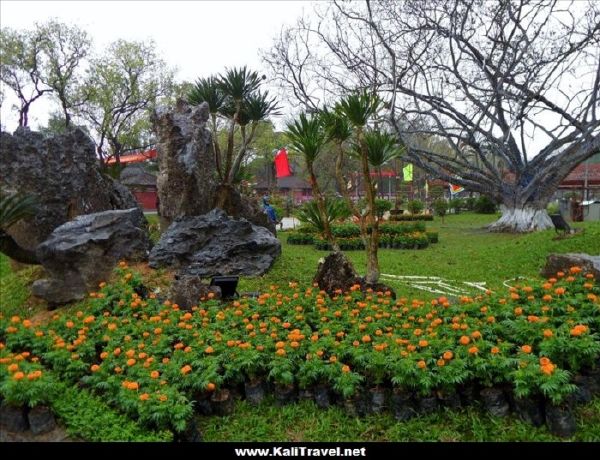
A walk down by the riverside gardens takes you past intriguing French Colonial buildings, such as Huế High School for the Gifted. The front gates are open and no one minds as I step into the driveway to look around.
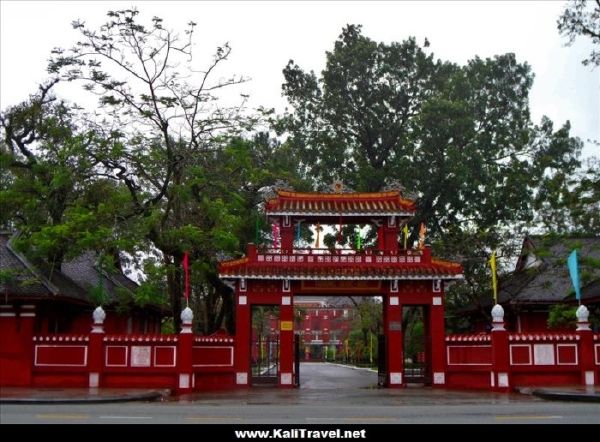
Quốc Học’ is one of the oldest secondary schools in Vietnam (1896) and one-time pupils include poets and presidents – the revolutionary Ho Chi Minh (who went on to become president of the nation) studied here until he was expelled in 1908.
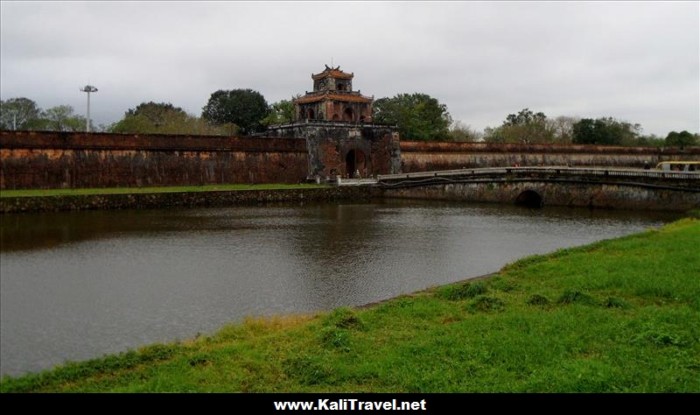
However, it’s over Phu Xuan Bridge onto the north embankment where the true attraction, the massive enclosure of the Imperial City, lies. Rickshaws pick up tourists for a lengthy ride around the outside of the massive stone walled perimeter but Juan and I just amble, exploring the tree-shaded avenues on the 10km circuit.
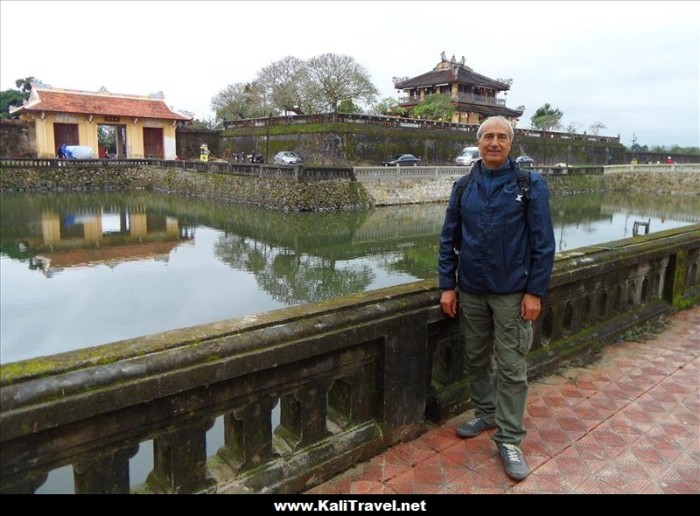
Water from Perfume River is channelled to the moat that encircles the fortress walls, and into the ornamental lakes inside the citadel where orangey gold koi fish swim between floating lotus flowers.
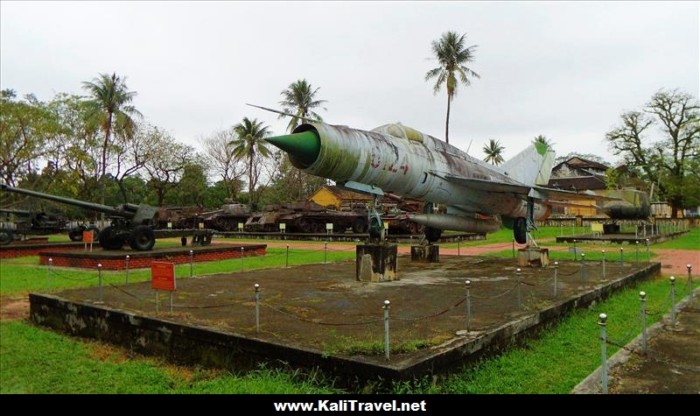
Thua Thien history museum’s open-air exhibition of war relics is just along the road – a disturbing compendium of Russian combat jets, Vietcong tanks, anti-aircraft missiles and a long ago captured US bomber plane. Alongside, street vendors wearing those timeless conical ‘straw hats’ sell flowers and pot plants from traditional bicycle carts.
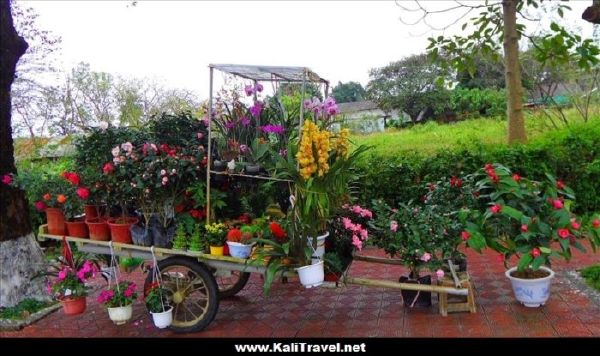
Hue – The Forbidden Palace
Day 2 in Hue
I wake up to teeming rain and it isn’t easing off anytime soon.
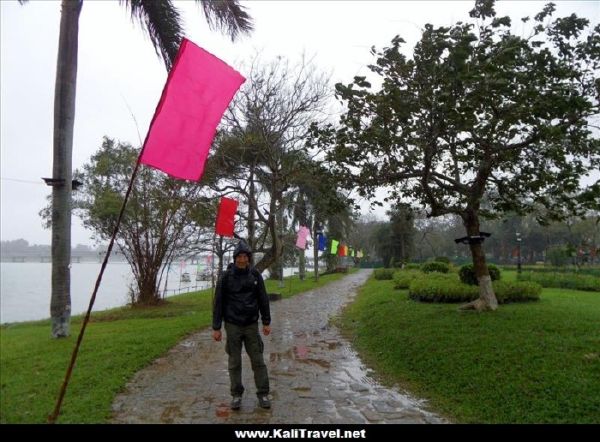
The entrance to the nineteenth century citadel (and the ticket booth) is easy to find on the riverside esplanade, over the moat bridge beside Meridian Gate. The Imperial City was practically destroyed during the war so what you see today, has been carefully reconstructed.
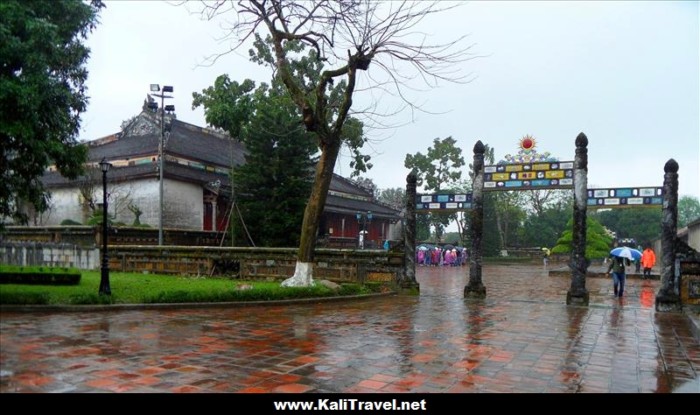
Pathways lead across this enormous enclosure to the few buildings still standing, 500 hectares of patios and gardens, and rough ground scattered with ruins.
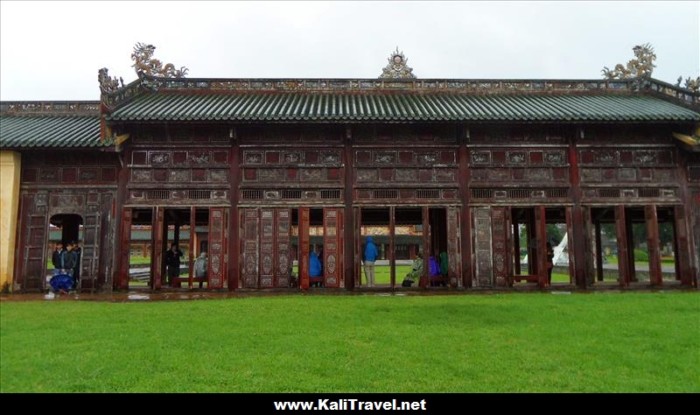
Step into the enigmatic World Heritage Site, pass through the rampart walls into the realms of the last Nguyễn dynasty and imagine what life was like two centuries ago for the privileged entourage of the Emperors’ Court…
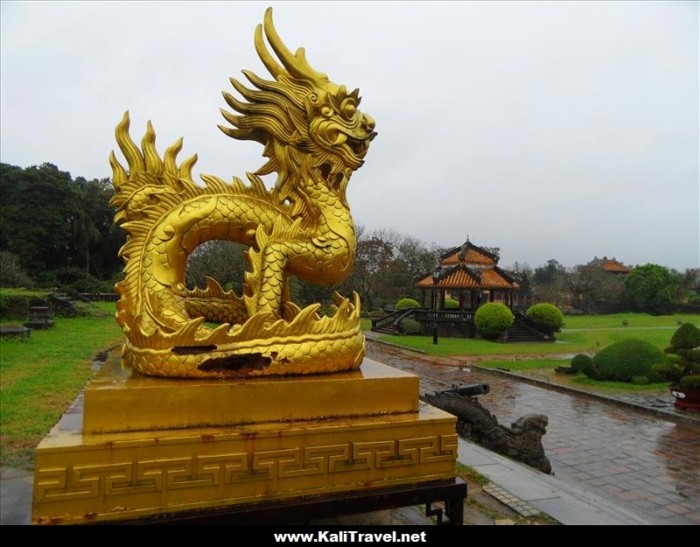
…the palaces and pavilions, temples and courtyards, and an inner sanctum – the ‘Forbidden Purple City’ where the Imperial family lived in utmost seclusion, the Emperor with his wives and concubines, and the legendary eunuch servants.
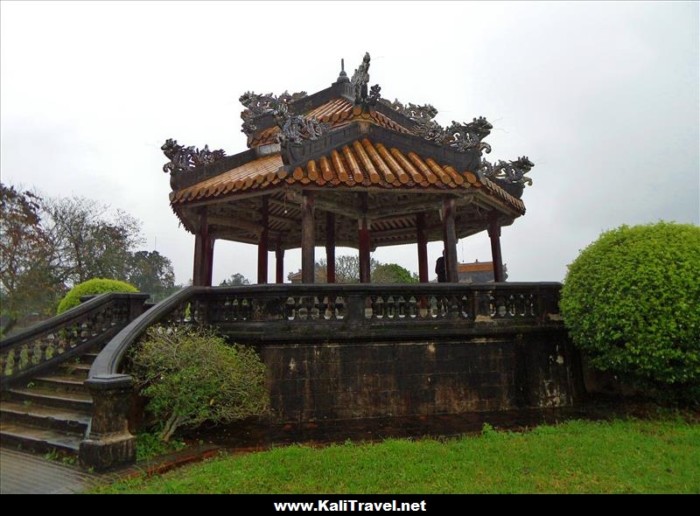
There were 160 edifices here originally in the 1800’s but even so the 10 sites left standing and the remaining treasures of the Nguyen heritage on display -includes the solid gold Royal Stamps, portraits of the Emperors, intricate wall hangings and priceless blue porcelain vases- give you an idea of the opulence of a lost era.
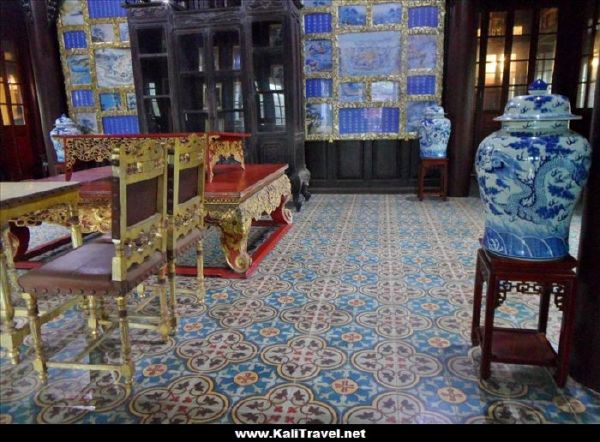
Our route around the Royal Enclosure
- The main entrance is through the ramparts at the ‘Meridian Gate’ Cửa Ngọ Môn.
- Immediately in front is ‘The Palace of Supreme Harmony’ Điện Thái Hoà and the ‘Esplanade of Great Salutation’ where court ceremonies were once held.
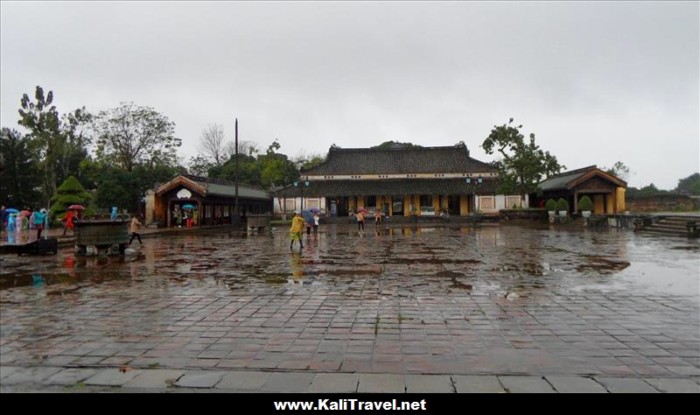
- The ‘Halls of the Mandarins’ Hữu Vu and Tả Vu are long low buildings aligned on either side of the great courtyard, near the entrance to the Forbidden Purple City. The unusual red lacquer galleries have been meticulously restored.
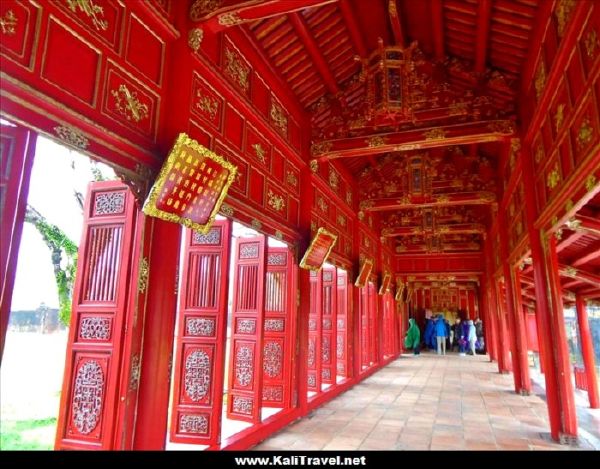
- To the left, the ‘Pavilion of the Glorious Coming’ Hiển Lâm Các stands out as the highest building in the citadel (3-storey).
- Carry on past the emblematic ‘Nine Dynastic Bronze Urns’ Cửu Đỉnh.
- The ‘Temple of the Generations’ Thế Tổ Miếu is to the west.
- Directly opposite is the ‘Temple of Resurrection’ Cửu Đỉnh, close to…
- …the ‘Chuong Duc Gate’ Cửa Chương Đức.
- Next visit the ‘Royal Theatre’ Duyệt Thị Đường.
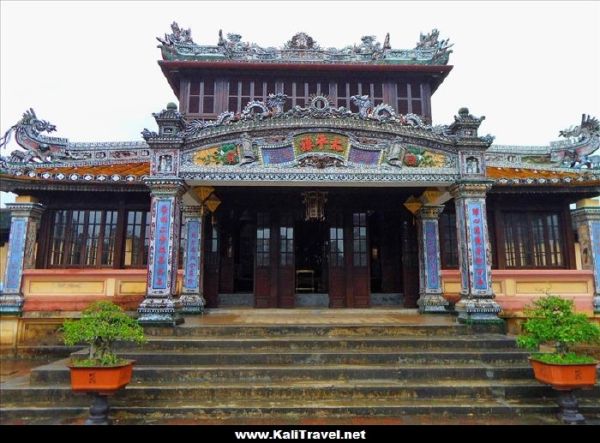
- Continue around to the ‘Royal Reading Pavilion’ Thái Bình Lâu (photos above and below). It’s an extraordinary site with ornate blue pillars, wooden French window patio doors and a gilded roof embellished dragons – the only building within the citadel which retains much of the original structure.
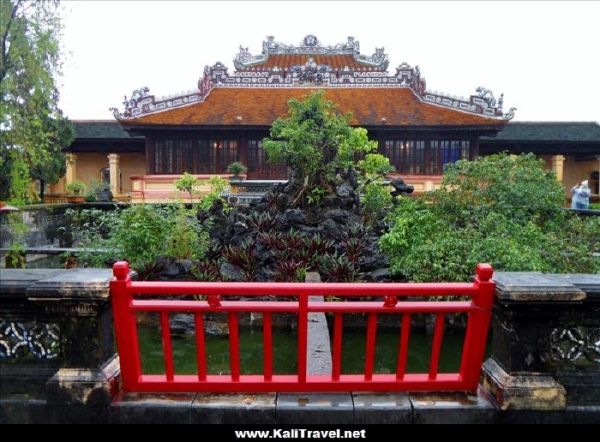
- The ‘Peace Gate’ Cửa Hòa Bình is on the northern boundary.
- Stop for a coffee at the Lầu Tứ Phương Vô Sự Pavillion next to the fortress walls.
- The ‘Longevity Palace’ Cung Trường Sanh, known as the ‘Grand Queen Mother’s Residence’, is where the reigning Emperor’s mother lived in privacy in the northwest corner of the Forbidden Purple City.
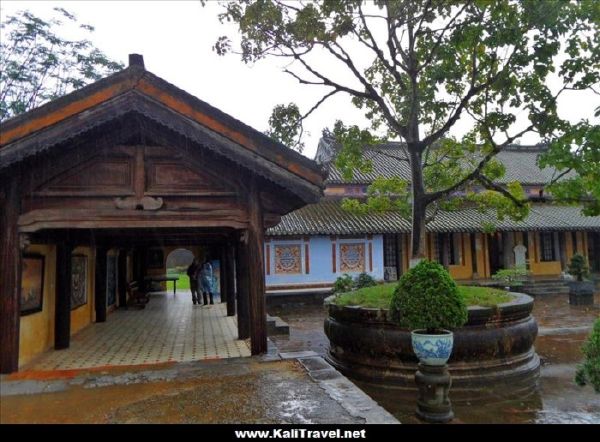
- Stroll around the northern section where there are ponds and gazebos, and a fierce Golden Dragon watches over the Co Ha Gardens.
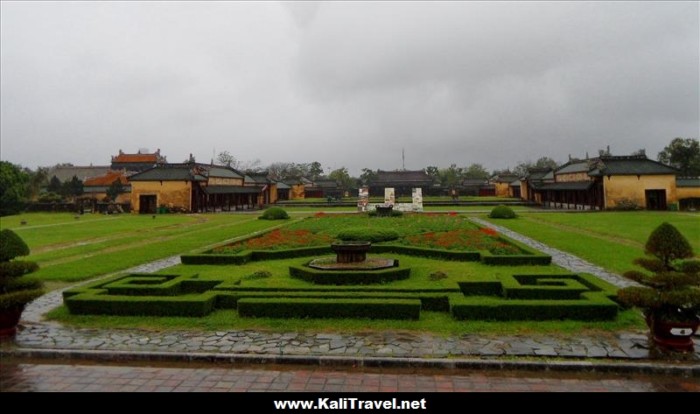
- Finally, walk back south along the Eastern side of the compound to the ‘Temple of the original Ancestor’ Triệu Miếu.
- Entry to Hue Museum of Royal Antiquities is included in the price of the Imperial City ticket. It’s located outside the citadel walls by Cửa Hiển Nhơn Gate.
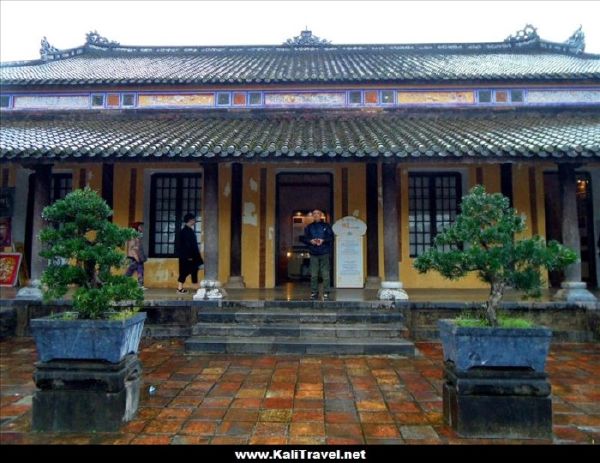
Photos are snatched in the torrential rain, a quick dash out with camera shielded by a plastic mac, and surprisingly some of them turn out ok. The sun comes out eventually so Juan and I linger awhile, until a guard politely shows us the way out at closing time.
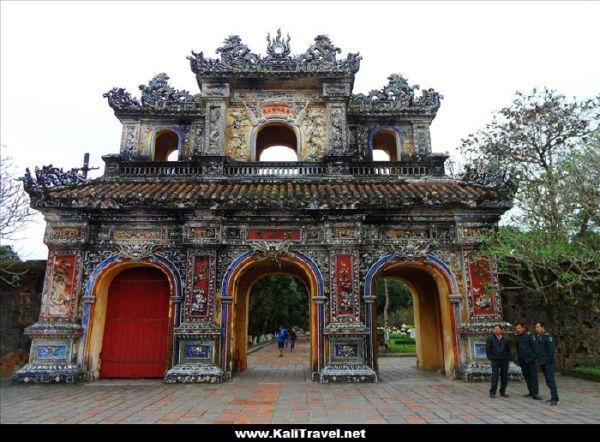
Hue is enchanting, no doubt about it, her scars are healing to reveal a beautiful and interesting destination. It would nice to stay longer, head over to the lagoons and beaches only a cycle ride away beside the South China Sea…but tomorrow we move on to Hoi An, a magical river setting backlit by hundreds of coloured paper lanterns.
Hue – What to See and Do
Tour the Imperial Citadel and Purple Forbidden City – Opens daily from 07.00 until 20.00 every day. Admission tickets can be purchased at the main gate. Entry costs 150,000 Dongs. There is no strict dress code. Our tips: Download an ‘audio tour’ app. Spare a couple of hours to walk around.
Take a stroll beside the River Perfume – A beautiful setting at any time of year, during autumn the air is filled with the scent of blossom which drifts downriver from fruit orchards bordering the riverbanks.
Cycle to the beach – The coast is only a 10 minute ride away! Enjoy a day lazing on powder white palm-fringed sands stretching away as far as the eye can see. Swim in the fresh water lagoon or dip in the South China Sea. Thuan An Beach is located some 13km northeast of Hue town centre, while Lang Co Bay, which is famous for its fresh seafood, is roughly 12km to the north.
Visit Hue’s famous Thien Mu Pagoda and other notable monuments, such as the Nguyen Emperors’ Tombs.
* If you stay over in Ninh Binh – Take a trip out to Tam Coc Caves, Trang An Grottoes and Hoa Lu Temples.
Useful Info for visiting Hue
Climate in Hue
The coastal area of Central Vietnam has a tropical monsoon climate. The rainy season typically affects Hue from September to January, with average daytime temperatures ranging from 20ºC in the winter (the coldest month is normally January) to the summer heat during May to August when it’s been known to reach 40ºC.
Accommodation in Hue
Everything from luxury hotel to hostels in the city, or beach resorts down by the coast.
Tip for budget travellers: We booked a twin room with private bathroom in a centrally located budget townhouse hostel, only a couple of streets back from the Perfume River.
How to get to Hue
Nearest airport
Hue Phu Bai Airport is 15km from the city centre. Flights to/from Hanoi, Ho Chi Minh and Da Lat.
By Bus:
The Southern bus station is approx. 2 km from the city centre; the Northern Bus Station is 5 km northwest. Tip: Tickets for a private buses (a faster alternative) can be booked through tour agencies.
By Train
Tran Van Cao Station railway station is located in Hue city centre. On the Hanoi to Ho Chi Minh north/south line.
A useful website: The Man in Seat 61 Train Travel in Vietnam.
Full transport itinerary for North, Central and South Vietnam
So far on our around-the-world adventure, I have made my own transport arrangements – however in Vietnam, to keep to a visa-free 15 day schedule, it’s better to book ahead. The Church Travels has a smart little office just near Hanoi Cathedral. This travel agency was highly recommended, and the service and attention really lived up to expectations.
I had already mapped out a route taking in the towns I wanted (and had time) to see, and worked out some budget accommodation, so Gnoc just arranged all the transport for me, suggesting the best alternatives including coach, boat, train and domestic flights!
Total cost: 4,540,000 VND for 2 passengers, working out at 86€ each (2018).
Related Posts on Vietnam
Sam Neua to Hanoi – Laos to Vietnam direct bus
The Sam Neua / Vieng Xai ‘direct’ bus to Hanoi. How to cross from Northeast Laos into North Vietnam at the Nam Soi-Na Meo border and on to Hanoi. Laos is an adventure no doubt about it…
A weekend in Hanoi is a great way to start a 15 day trip of nonstop adventure through Vietnam! Follow our guide to discover one of Southeast Asia’s most intriguing countries…
Cat Ba is a good base for exploring Halong Bay, an idyllic island which is mainly untouched by tourism. Fancy a cruise on a traditional junk or a nature walk through protected parkland…?
Overnight Train to Hue Citadel
Hue is the next must-see destination on our 2 week travel guide and the overnight train from Binh Ninh is a great way of getting there…
To read more World Trip adventures CLICK HERE
Discover the World with![]() the blog with a focus on independent travel
the blog with a focus on independent travel




